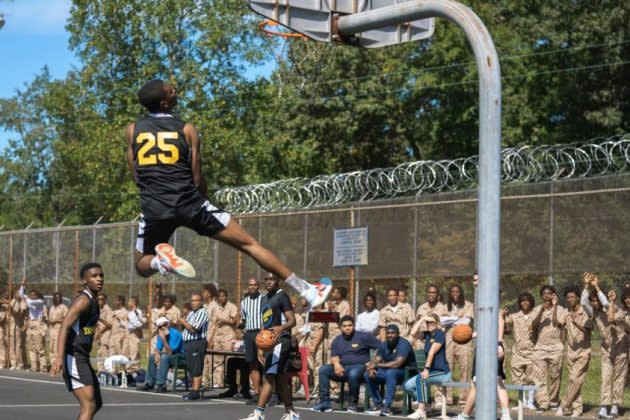‘Swagger’: How ‘1917’ Inspired Reggie Rock Bythewood to Pull Off a 12-Minute Long One-Shot Basketball Scene
- Oops!Something went wrong.Please try again later.
- Oops!Something went wrong.Please try again later.
- Oops!Something went wrong.Please try again later.
- Oops!Something went wrong.Please try again later.

SPOILER ALERT: This contains spoilers from “Swagger” Season 2, now streaming on AppleTV+.
As Reggie Rock Bythewood was gearing up for AppleTV+’s second season of “Swagger,” the filmmaker was thinking about how to elevate the series and take it to another level.
More from Variety
John Wilson Talks 'Existential Themes,' Nathan Fielder and the Final Season of 'How To'
'Secret Invasion' Director Ali Selim Dissects the Season Finale and Reacts to the Mixed Reviews
One film that came to mind was Sam Mendes’ “1917” and how cinematographer Roger Deakins had shot the film and presented it as if it were one continuous long shot.
The series follows a team of basketball players inspired by NBA star Kevin Durant and in the latest “maze,” as Bythewood calls it, the team down to six players, Jace (Isaiah R. Hill), Phil (Solomon Irama), Musa (Caleel Harris), Drew, Royale (Ozie Nzeribe), and Nick (Jason Rivera) head to Maryland’s Youth Facility, a detention center for young offenders for a game. “I thought about ‘1917’ and the entire film is shot as if it were one shot. So, Cliff Charles, the D.P., and I talked about doing one that way,” says Bythewood.
He worked with Charles and camera operator John Lyke on how to execute the scene. The key was to keep the scene grounded in the performances, and with the juxtaposition of the fencing and bars in the detention center to keep the idea of “ultimate freedom during the game.”
When Bythewood came to Charles, the D.P. had not seen what the choreography would be. “I started to think about where could do a seamless cut to make it feel like it was a oner. But Reggie came back and said, ‘Let’s make it a oner.'”
Given that the shot would be at least 12 minutes long, the first thing Charles did was get Lyke a lighter camera. Once they had the gear, Charles says, “We were able to rehearse it a few times. We started to feel really good about our prospects of doing it all in completely one shot which is exactly what we did.”
Lyke notes this was not the first time they had been tasked with shooting continuous long shots or oners with hidden or no edits. Bythewood had suggested the use of rollerblades over five years ago to help achieve the shots they were after.
With division one players among the actors in the scene, the trio knew the scene would be a high-intensity environment with great basketball plays. Says Lyke, “Every character had a different feeling in that moment, and so we bounce between those different storylines. Reggie always likes to emphasize real basketball.”
A lot of shots weren’t going to be made, the ball would be stolen at times and Bythewood didn’t want to yell cut. Says Lyke, “Reggie said, ‘What if we bake in those improvised moments?’ And I would have to navigate what happens and we all try to collectively get back to the original storyline, but we’re also open to the shots being missed. What if they don’t win the game and we go from there?”
What did that mean for the story and the game?
Charles, Lyke and Bythewood explained to every member of the crew and cast that on the fly, Lyke would make creative and visual decisions that would be completely based in the story, and when things would go awry, they would try to bring it back. “We were completely immersed in that process and what’s going on that I think that’s what helps for it to come across to the audience that way as well,” Charles says.
Adds Bythewood, he had told the cast there would be no cuts in the scene. “If you miss the shot, it will go in the show that way. If you miss it, you better get the rebound.” The director says he went back and looked at some of the rehearsal footage. One shot that stood out in that footage was Jason Rivera who plays Nick Mendez “did a beautiful reverse dunk, in every take. Except for the one we used,” says Bythewood. “We did ten takes of the scene but there was no cutting, and props to John for staying with it.”
Yes, a few shots were not made in the take that had been rehearsed, but Bythewood is happy with the results. Not only is the audience actually rooting for the other team to win, he says, those misses, “from a pure story standpoint, worked.”
Adding to the power of the moment is an appearance by John Carlos.
Before the game, the group of underprivileged boys are introduced to the real-life Olympic hero who in 1968 stood on the podium at the Olympic Games and gave a Black Power salute. Bythewood reveals they didn’t have much time and the scene was not on their shortlist, but they put Lyke on his rollerblades to capture it. Says Lyke, “The energy John brought to the air was different,” he says as he captured the boys raising their fists, panning around. “You felt that from every generation there.”
Bythewood says, “We wanted to capture those emotional moments [of the game] and step outside it to another one. And that was important and something else that felt heightened.” Having Carlos there was “a real-life piece of history, sports history, Civil Rights history. John raised his fist in the air during the national anthem.” He adds, “There was something that just felt emotionally heightened that this icon was with us.”
Watch a clip above.
Best of Variety
Sign up for Variety’s Newsletter. For the latest news, follow us on Facebook, Twitter, and Instagram.
